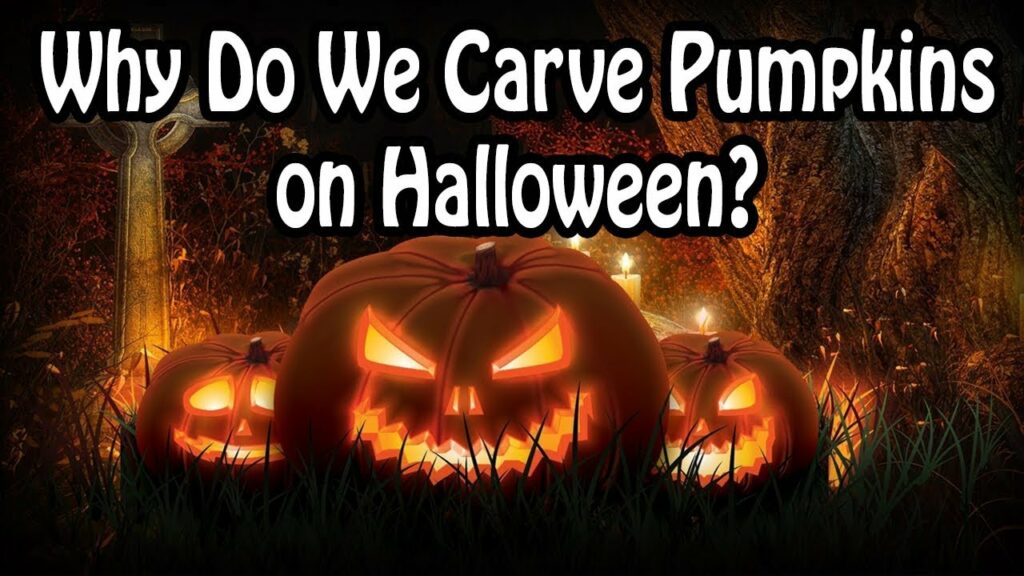Why Do We Carve Pumpkins at Halloween?

Despite the fact that our beloved demonic faces haven’t always been carved out of pumpkins, the jack-o’-lantern has a long history with Halloween.
Their roots are in an Irish folktale of Stingy Jack, who conned the Devil to his own financial advantage. Jack was destined to wander the earth for all eternity because God and the Devil refused to let him into either heaven or hell when he passed away. Turnips were first carved into the faces of demons in Ireland to scare away Jack’s wandering spirit. Since pumpkins are local to the area, Irish immigrants to the U.S. started making jack-o’-lanterns from them.
Also Read:- Why Do We Celebrate Halloween?
However, how did jack-o-lanterns come to be connected to Halloween? Halloween is founded on the Celtic holiday Samhain, which was celebrated in ancient Britain and Ireland on October 31 to celebrate the end of summer and the start of the new year. During Samhain, it was thought that individuals who had passed away that year departed to the otherworld and that other spirits would come back to their homes.
All Saints’ Day, a day honouring the church’s saints, was relocated by the Roman Catholic Church to November 1 in the eighth century CE. As a result, Halloween (also known as All Hallows’ Eve) fell on October 31. Samhain customs have persisted, such as the practice of dressing up to hide from ghosts that may be prowling around your house. Stingy Jack’s legend was swiftly adopted into Halloween, and ever since, we’ve been carving pumpkins (or turnips).
Pumpkin carving is a popular Halloween costume for many of us. But have you ever considered the origins of the holiday custom? The origins of Halloween as we know it can be traced back to the ancient Celtic festival of Samhain. Samhain, which was observed at the conclusion of the summer, was a time to remember the dead. The Celts thought that the souls of people who had died that year would pass away between the hours of sunset on October 31 and the hours of dusk on November 1, so that this was also the time when ghosts would be most active. People hung carved jack-o-lanterns in windows and on porches to ward off evil spirits. Turnips, beets, or potatoes were carved into their constructions, and burning coal chunks were placed within to provide light.
Why Do They Have the Name “Jack-o’-Lanterns”?
The phrase “jack-o’-lantern” is thought to have sprung from an Irish folktale about a trickster named Stingy Jack. Jack was unable to enter either heaven or hell after he passed away, so he was left to wander the earth as a ghost while toting a turnip-carving lantern. Prior to the widespread availability of pumpkins (which provided greater room for carving), people used to carve turnips and other vegetables for Halloween. Because Stingy Jack carried his carved lantern around, these pumpkin carvings eventually came to be known as jack-o’-lanterns.
How Jack-o’-Lanterns Arrived in the US
In the 1800s, Halloween was introduced to America by Irish immigrants. When these immigrants arrived in America, they learned that pumpkins make excellent jack-o’-lanterns. Pumpkin carving is still associated with Halloween in modern times. In actuality, Halloween accounts for the majority of the 1.5 billion pounds of fresh pumpkin types harvested in the United States annually. Other European nations like Ireland and England also like carving pumpkins. Try carving your own Halloween jack-o-lanterns this year with a pumpkin carving kit ($11, Target) and our free pumpkin stencils.
Jack-o’-lanterns in other cultures
Candles are almost always used in civilizations that still entreat the dead to come back for one night, according to Fallingstar. This practice, for instance, is observed during Dia de Muertos in Mexico. She continues, “But I think only the Celtic culture employs jack-o’-lanterns, which are replica skulls, to welcome some and drive out others. However, she notes that Japan does have a somewhat comparable custom: “On their day of the dead, which they call Obon, the Japanese light four-sided paper lanterns on miniature wooden rafts and send them down rivers to escort their dear spirits back home on a stream of light.” Here are some additional inexpensive Halloween decorations to attempt this year in addition to your jack-o-lantern. Check out these no-carve pumpkin ideas for Halloween if you don’t have time to carve a jack-o’-lantern this year.







